Top Image: Sigismund’s Column, originally built in 1644, is demolished by German tanks. Warszawa: Iskry, 1957.
On August 5, 1944, Governor-General Hans Frank messaged the Reich Chancellery an update regarding the Warsaw Uprising. In it, he stated, “For the most part, Warsaw is in flames. Burning down the houses is the most reliable means of liquidating the insurgents’ hideouts.” Frank also noted the indescribable poverty among the millions of inhabitants and promised Hitler that Warsaw would be punished “with complete destruction after the suppression or collapse of the [up]rising.” Despite considerable German losses on the Eastern Front, Frank remained confident that the uprising could be crushed in a few days.
The first week of the Warsaw Uprising, which was launched on August 1, 1944, brought little satisfaction to either side. The Polish Home Army (Armia Krajowa or AK) had not been able to seize full control of the capital and the Germans had not crushed the insurgents. The opening attack by the AK and the subsequent German counterattack on August 5, 1944, had fallen short of their goals. Far more civilians had been killed than combatants, yet the fighting relentlessly continued until the first week of October. While morale among the civilian population was initially high after the outbreak of the insurrection, it gradually declined throughout August and September as German forces massacred entire neighborhoods, razed historic Old Town, and Stalin refused to intervene.
The German Response to the Warsaw Uprising
When the Nazi governor of Warsaw, Ludwig Fischer, heard news of premature clashes on the afternoon of August 1, 1944, he put 5,000 SS (Schutzstaffel) police and SD (Sicherheitsdienst) personnel on full alert, ordering them to secure key positions throughout the city, including the Governor’s Place and the German quarter. Loudspeakers warned Warsaw’s inhabitants that “bandits” were operating against the Nazi government and cautioned that any civilian found on the street would be fired upon.
That evening, Wehrmacht officers met at the headquarters of General Nikolaus von Vormann, who had recently been made commander of the 9th Army. Those at the meeting decided not to redirect Wehrmacht forces from the Eastern Front. Instead, 9th Army Command requested additional police formations to be brought in and put the SS in charge of crushing the uprising.
Many Nazi leaders, including Reichsführer SS Heinrich Himmler, considered the uprising a pretext for destroying the Polish capital once and for all. According to his own recollection, in describing to Hitler how events unfolded, Himmler stated:
“The moment is a difficult one. [But] from the historical point of view, the action of the Poles is a blessing. We shall finish them off…Warsaw will be liquidated; and this city, which is the intellectual capital of a sixteen to seventeen million-strong nation that has blocked our path to the east for seven hundred years, ever since the first battle of Tannenberg, will have ceased to exist. By the same token, the Poles themselves will cease to be a problem for our children and for all who will follow.”
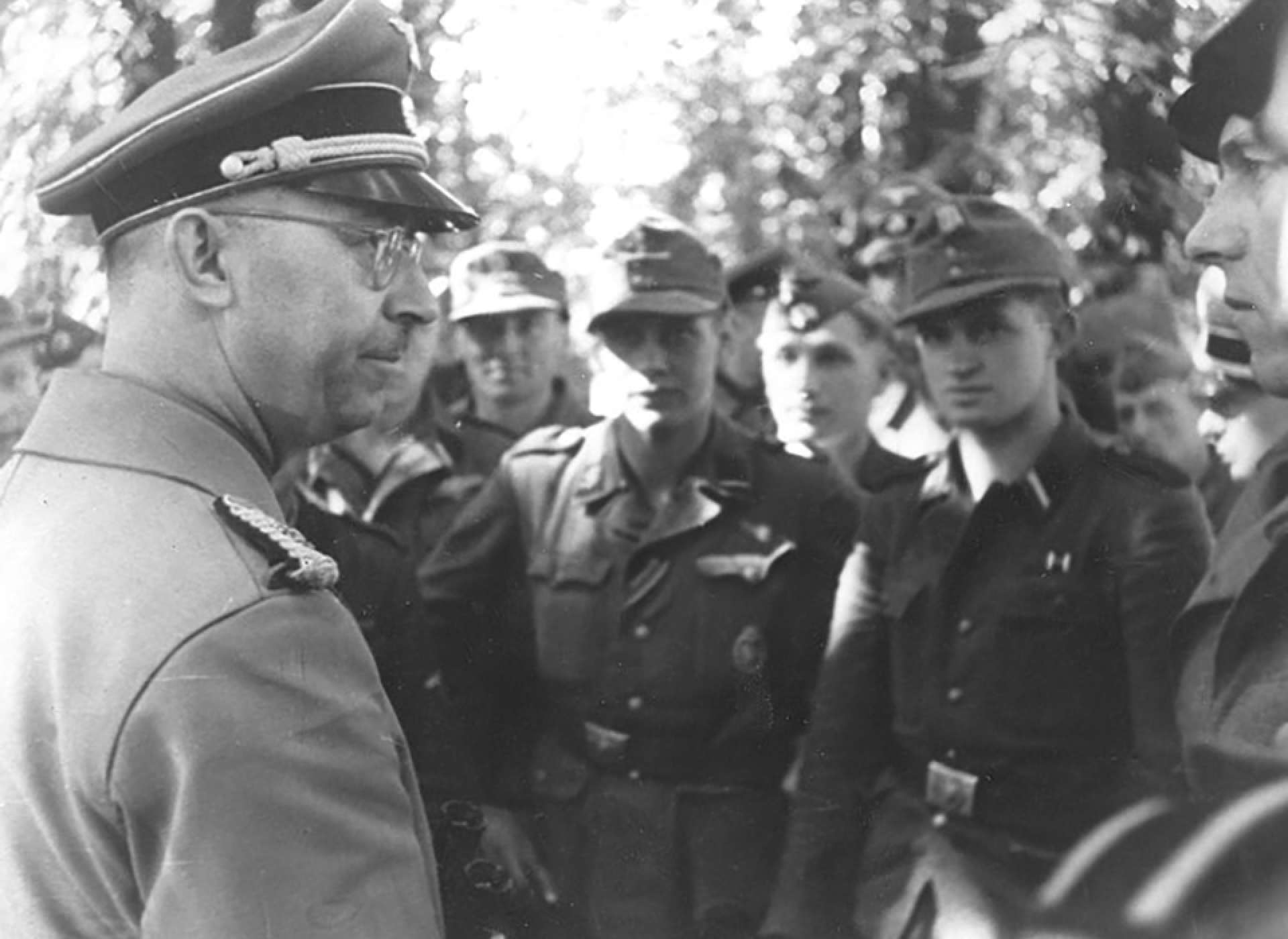
Heinrich Himmler (left) talking to SS soldiers, October 1944, Wydawnictwo Prasowe Kraków-Warszawa.
Although Hitler’s immediate response was not recorded, he had threatened the destruction of several European cities in the past. Only three days prior, he reportedly ordered Warsaw “to be crushed with great force” in the event of an uprising. Unsurprisingly, Hitler and Himmler agreed the Warsaw Uprising needed to be brutally suppressed and issued the Order for Warsaw on August 1, 1944. It explicitly stated that the entire city needed “to be levelled to the ground in order to set a terrifying example to the rest of Europe.” A subsequent directive included the fateful order that “every citizen is to be killed including men, women, and children.”
To achieve this, Himmler ordered the mobilization of a special anti-insurgent corps to be commanded by General Julius Eberhard von dem Bach. After securing key German positions in Warsaw, this Attack Group set out to flatten the city and kill all its inhabitants. As the historian Halik Kochanski has indicated, “German tactics were clear from the outset: no distinction was to be made between AK soldiers wearing identifying armbands and the civilian population.”
The Assault on Wola and Ochota
To suppress the uprising, the German SS Command developed a two-prong attack plan, intended to push through the western suburbs of Warsaw and Old Town in order to reach the Vistula in only two days. Himmler’s instructions to General von dem Bach specifically read:
- "Captured insurgents ought to be killed regardless of whether they are fighting in accordance with the Hague Convention or not.
- The part of the population not fighting, women, and children, should likewise be killed.
- The whole town must be leveled to the ground, i.e., houses, streets, offices—everything that is in the town."
After principal reinforcements arrived on August 3-4, General von dem Bach ordered the attack on Wola and Ochota, the two westernmost districts in Warsaw. Under the leadership of the German SS commander Heinz Reinefarth, close to 4,000 SS troops attacked Wola at 7:00 a.m. on August 5 at Wolska Street, then known as Litzmannstadtstrasse. In a report to the exiled Polish government in London, General Bor Komorowski, commander of the Polish Home Army, described SS tactics in Wola:
“The Goliaths [remote controlled miniature tanks filled with explosives] were the first to attack. Their object was to blow up barricades and heavy concrete structures…The Goliaths were followed by heavy Tigers which attacked while firing at short range. Only then did the infantry begin—by that time they were usually faced with ruins. The enemy was allowed to advance unchallenged, sometimes to within a grenade’s throw, sometimes into a building. It was often hand to hand [combat].”
The attack came as a surprise to those living in Wola—many thought the artillery fire and explosions signaled the arrival of the Soviet Red Army. Once it became apparent that Germans were attacking, civilians tried to hide in cellars, courtyards, and garages as the 1st Aircraft Division dropped dozens of incendiary bombs on the district. John Damski, one of the many civilians caught up in the violence, described the horrific result of these bombs as he and his wife tried to seek shelter:
“The Germans started burning houses. Our building was already on fire. We were trying to extinguish the flames, but I couldn’t keep it up for long…We moved to the next building, then that house burned out. We saw what was the remains of a garden plot; somebody had dug a hole, just large enough for the two of us to slide into. Cinders were flying everywhere. You couldn’t see the sun for all the ashes; it was like a huge orange ball. All of Warsaw was burning. I had to urinate on my handkerchief and cover [my wife’s] head with it, to keep her hair from burning. We stayed in that hole for three days…”
Yet, for many people there was simply no way to escape as SS units threw hand grenades into basements, set buildings on fire, and shot anyone trying to flee. Although the AK attempted several counter attacks on August 5, later named “Black Saturday,” they soon retreated because thick smoke from the raging fires prevented them from seeing each other well enough to coordinate any meaningful defense.
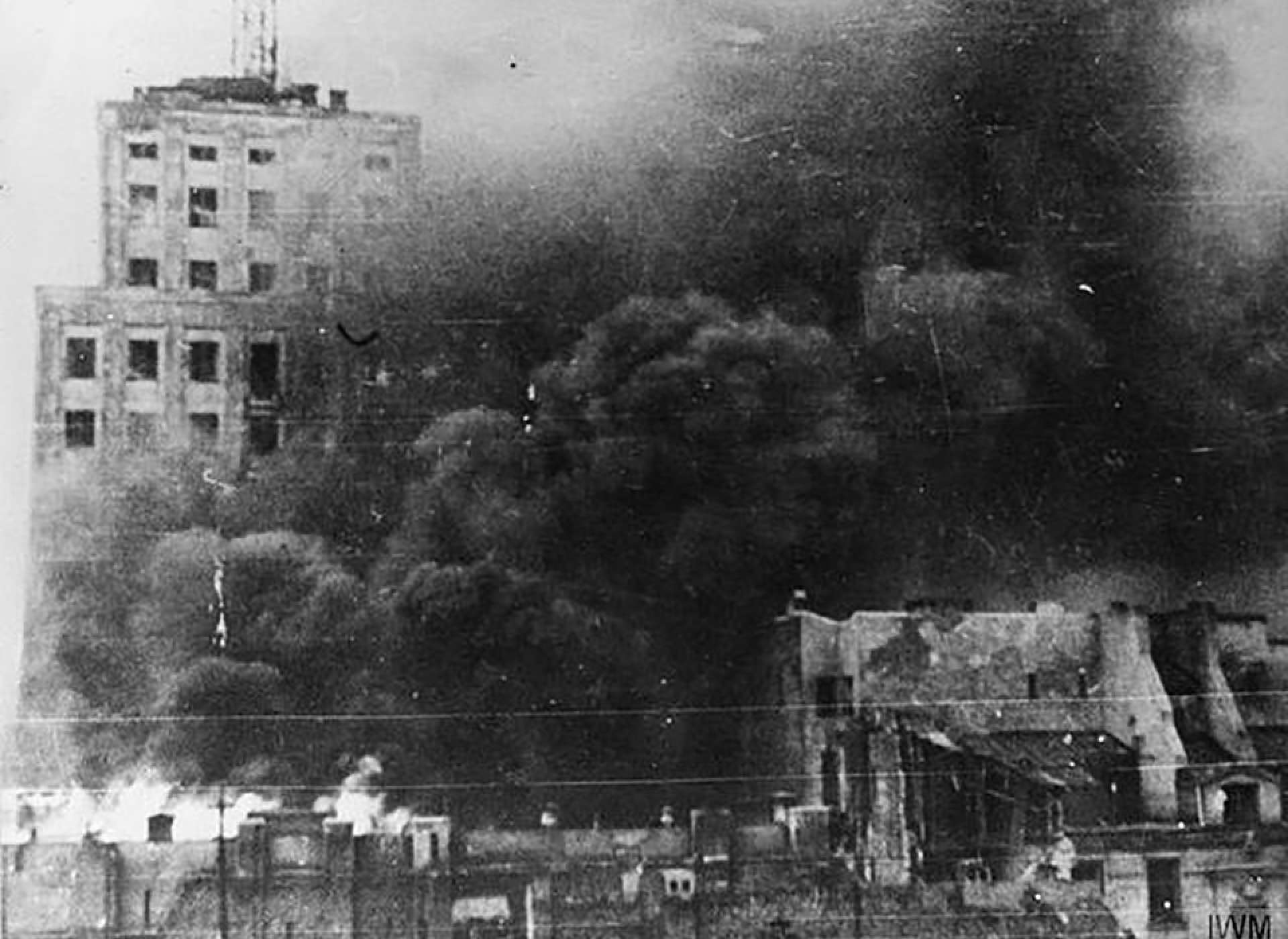
The Prudential skyscraper in flames at the height of the Uprising. Keystone Press Photographer, The Warsaw Uprising, August-October 1944, Warsaw, Imperial War Museum, HU 105735.
As the Germans moved into the densely populated working-class neighborhoods in the center of Wola, they set entire housing complexes and factories on fire. German troops, for instance, surrounded the massive Wawelberg cooperative that encompassed the blocks at Górczewska 15, sealed the gates within minutes, threw hand grenades into the basements, and set the entire complex on fire. According to one witness, “people were burning alive and engulfed in flames and ran to the windows. Nobody upstairs could escape from the fire; they were all burned alive.”
The Hankiewicz Houses at Wolska 105-109 were the next buildings to fall. After surrounding the houses, the SS threw in a white incendiary powder which they carried in large bags. Almost everyone in the building was burned alive or killed by hand grenades. One man remembered seeing a group of Germans gather civilians who had been hiding in the cellars at Płocka 28 and execute them in the courtyard with a machine gun. Wacław Gałka described how she survived the mass murders after being forced from her home by SS troops:
"We were taken to Wolska Street and immediately saw piles of dead men, women, and children, the inhabitants of Wolska 128-129 who had been executed there…When the police shot my son I could feel his blood dripping on me, and that is probably why they thought I was also dead.”
The killing continued throughout the day and by 1:00 p.m. a number of execution sites had been set up including the tram depot at Młynarska Street, a macaroni factory at Wolska 60, the railway viaduct at Górczewska 15, Sowiński Park, and the Franaszek and Ursus factories at Wolska 122-124. As civilians fled burning buildings, SS troops rounded them up and led them at gunpoint to the nearest execution site, where they were systematically shot.
Oscar Dirlewanger’s Brigade, known for its cruel tactics in Belorussia, proved to be the most vicious during the assault on Wola. In addition to SS and SD commandos, Dirlewanger’s Brigade was made up of Russian soldiers (deserters and ex-prisoners), eastern Muslims from the North Caucasus, and Azerbaijani units.
The most terrible features of the Dirlewanger Brigade were the willful murder of children and the mass rape of women. Matthias Schenk, a sapper in the 46th Assault Brigade, later recalled that “rape was the norm” in the Dirlewanger Brigade. Schenk also witnessed the brigade massacre all the inhabitants of the Orthodox Children’s Home as well as all the patients and staff at the Wolski hospital.
As SS units annihilated the population of Wola, the Kaminski Brigade unleased a wave of terror in Ochota, a district to the south of Wola. The first few days of the Warsaw Uprising were relatively calm in the wealthy area, and many residents were surprised by the insurrection since the AK only had about 400 troops stationed there. Although the SS rounded up people on August 2, most were suspected AK members and the remainder of the population had no reason to suspect the brutal violence that was to come.
Heinz Reinefarth launched his attack on Ochota at 8:00 a.m. on August 5 with 1,700 men from the SS RONA Brigade, made up of troops from the Russian National Liberation Army under the command of Mechislv Kaminski and a 400-man police battalion. As they descended on the Staszic and Lubecki housing estates, the RONA Brigade looted, robbed, raped, and murdered as they advanced through the district.
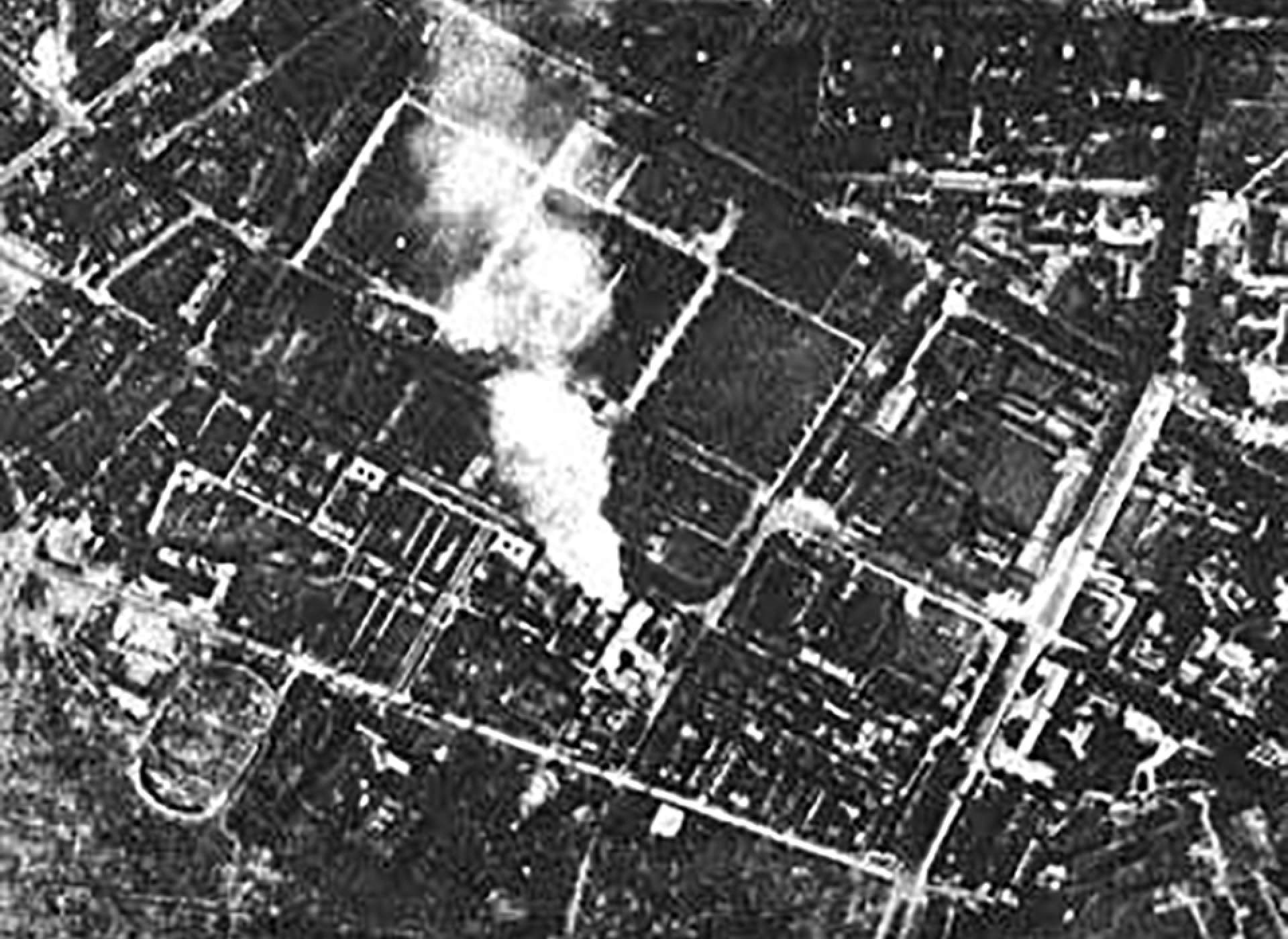
Warsaw Uprising aerial photo taken by an RAF pilot. The photo shows part of Ochota district on the left. Warsaw Uprising aerial photo, August 1944, Warsaw in Opracowanie Zbiorowe, Powstanie Warszawskie w Ilustracji: Wydanie Specjalne Warszawskiego Tygodnika Ilustrowanego, Stolica, 44.
In the first wave of attacks on Ochota almost all young men were immediately shot. Those that were spared were rounded up and taken to the Zieleniak land at Grojecka 95, which had been the site of a large farmer’s market in Warsaw before the war. During the uprising, however, the SS turned it into a makeshift concentration camp. By the end of the day on August 5, SS troops crammed over 8,000 people into the walled field without providing any shelter, food, water, or electricity. In the following days, the number of people grew to 20,000. A German law professor, who was conscripted by the Wehrmacht, described the sight as SS units removed thousands of residents from their homes and transported them to Zieleniak:
“We continued in the direction of the city center, but travelled only a few meters, because of the intense fighting…A never ending column of miserable people shuffled by. It was the most shocking site. Women, children, old people. Deadly tired faces without a shadow of hope, eyes swollen from smoke and tears, faces covered with shoot, a picture of despair and doubt. Policemen with machine guns walked beside them.”
Due to the mass murders in Wola and Ochota, on August 6, General von dem Bach issued a new policy: Himmler’s Attack Group was to concentrate on crushing the AK, executions were to be handled only by special Einsatskommandos, and only men were to be shot. He also established a transit camp west of the city for refugees. Ninety percent of the people forced to leave their homes in Warsaw were “processed” there before being sent to concentration camps throughout the Reich, forced labor camps in Germany, or small villages in the General Government.
Estimates of the number of people killed in Wola and Ochota between August 5-6, 1944, range from 35,000-50,000. According to the historian Alexandra Richie, these murders were not part of “a simple military operation designed to clear a transportation route through a large city,” as some German officers would later claim. Instead, the massacre constituted “an SS-led ‘Aktion meant to punish, terrorize, and kill the population of a district of Warsaw as a deterrent to the rest of the city.”
The Assault on Old Town
Once the Germans took Wola, they turned their attention to Old Town. The centuries-old district was operationally important due to its proximity to the Vistula River and Kierbedz Bridge, which was vital for the Germans to continue supplying troops to the Eastern Front. Reinefarth assumed that the battle for Old Town would take about a week since they were able to take Wola and Ochota so easily, but he did not consider the fact that Old Town had been a secure base for the Home Army. AK troops, numbered close to 8,000, had time to prepare fortifications, carefully craft barricades, and procure weapons. Also unbeknownst to Reinefarth, two of the most experienced AK commanders—Jan Mazurkiewicz and Colonel Karol Ziemski—had recently arrived in Warsaw to lead the battle on Old Town.
Old Town, situated along the bank of the Vistula River, comprised a maze of narrow streets clustered around St. John’s Cathedral, the Royal Castle, and Old Town square. Established in the thirteenth century, and surrounded by medieval battlements, it was a vital symbol for the city’s history and heritage. Old Town itself, was “a natural fortress and one of the few European cities to have retained its original walls, punctuated by massive gates including the sixteenth-century Barbikan built by the Venetian architect Jan Baptysta.” At the heart of the district lay Old Town square, a popular location for fairs, markets, feasts, and celebrations with a parade of shops, cafes, and tall, colorfully painted houses.

After the war, citizens reconstructed Old Town Square exactly as it had been. Photo taken by author in 2017.
The Germans began their attack against Old Town on August 11, 1944, by striking the outlying streets, but ran into resistance fighters at every turn. According to Richie, “attempting to take Warsaw’s Old Town was like fighting for a medieval fortress, with its tiny streets, houses with thick, heavy walls, deep cellars and catacombs, and an entire underground network of streets and passages connecting one end to the other.” Himmler reportedly complained several times about the “maze of passages and catacombs,” which prevented an easy German victory.
The struggle for Old Town was characterized by intense close-range combat and a number of buildings and warehouses changed hands multiple times during the last two weeks of August. The worst aspect for the Germans proved to be Polish snipers, who effectively hid in well-constructed barricades and in the ruins of burned buildings.
The German struggle to take the outer streets of Old Town led to a false sense of security among civilians living inside the medieval “fortress.” According to one German SS fighter, on August 14 Old Town appeared to be full of life, with groups of civilians sitting outside reading newspapers and listening to music. “Civilian organizations were hard at work setting up food posts so people could get something to eat a few times a day. There was enough water, the churches were full, and people made altars and prayed together in their courtyards.”
Convinced they would be safe, refugees from Wola and Ochota flocked to the safety of Old Town. Jews also came out of hiding because, as one Jewish woman stated, “I was only in danger the same way all the other inhabitants of Warsaw [were]…For the people around me I was one of them and not someone especially marked out.” In his memoir of the Warsaw Uprising, Miron Białoszewski described the atmosphere in the protected district during the second week of August:
"It was already a famous redoubt. Impregnable. Barricades. Serpentine streets. Not for tanks. Stare Miasto is strong. Its walls are solid. Thick. People felt secure; when they greeted one another they would say, ‘Today is the twelfth day of the uprising,’ as if it would soon be over.”
By the third week of August, however, the Germans had surrounded the city and began a ruthless siege on Old Town. The Luftwaffe dropped over 1,580 tons of bombs, the effect of which was made worse by the fact that Stalin refused to send his own planes in to assist the Poles. Having free reign in the air, German planes took off without fail at 6:00 a.m. each morning, strafing civilians, and dropping bombs every half hour. At midday, the pilots took a break for lunch and then continued to drop bombs until 7:00 p.m. Krowa, or German rocket launchers which could fire high-explosive rounds amazing speed, and incendiary bombs fueled the fires that were already burning on the ground.
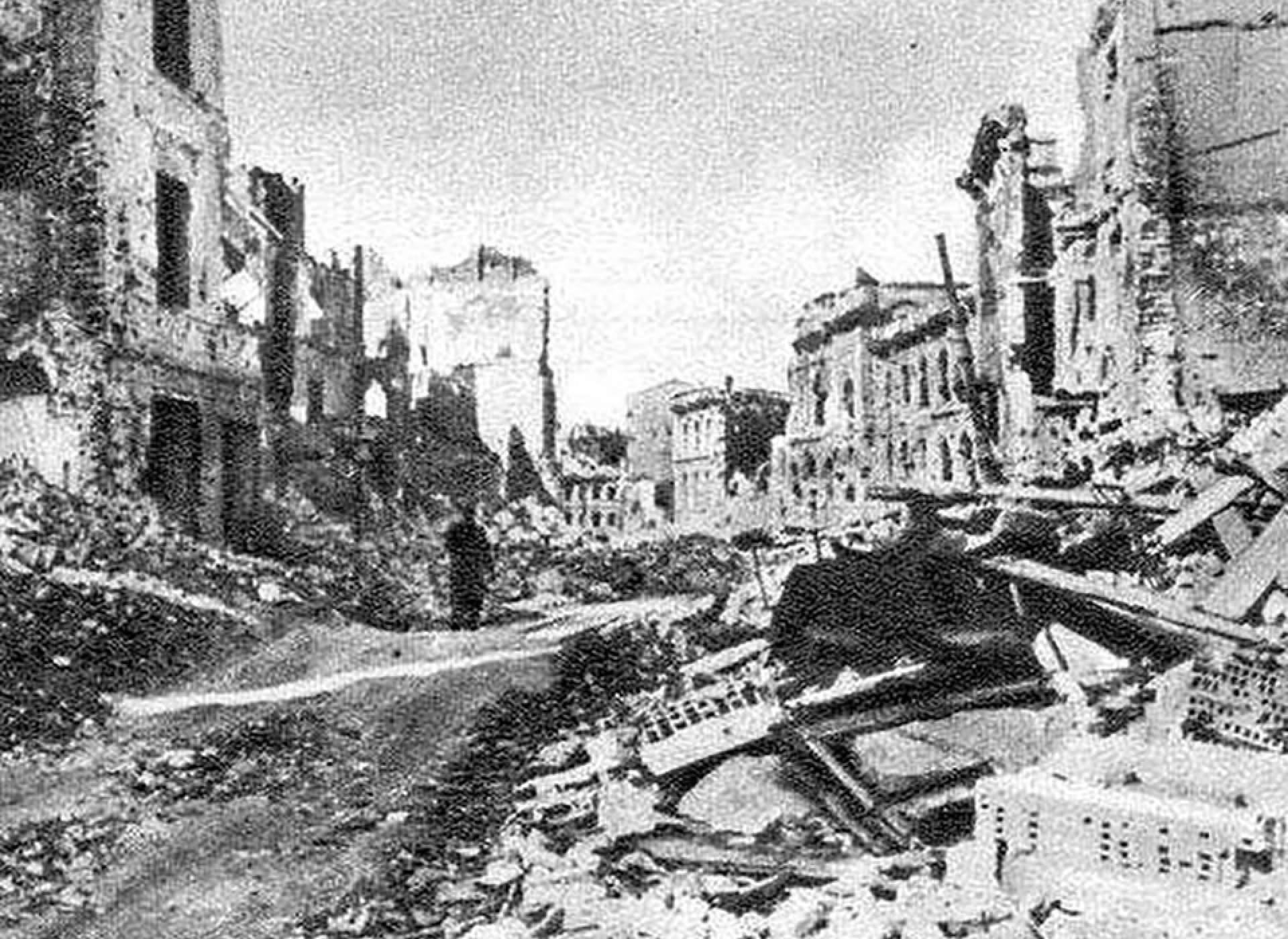
Ruins on Bielańska Street after German bombs destroyed the neighborhood on September 1, 1944. The ruins of the “Bank Polski” building are clearly visible on the right. Adam Borkiewicz, Powstanie Warszawskie 1944, Warsaw: PAX, 1957.
The result was catastrophic. Hundreds of men, women, and children perished in the flames or rubble and dozens of historic buildings were razed to the ground. In describing the effect of incendiary bombs, Miron Białoszewski wrote, “Fire is burning everywhere. It is so hot the asphalt is melting…[houses] are on fire…they are smoldering and hissing. Beams groan, collapse. Nothing can help at this time.” As roofs collapsed and ancient buildings burst into flames, Irena Orska wrote about the horror at witnessing the destruction of the city:
“The beauty built up through the centuries of Polish history was burning to ashes before our bloodshot eyes…the slenderness of the fourteenth-century Cathedral of St. John, and Knight’s Street, the narrowest in Old Town, and the polychrome of the ancient Market Place…I cried in helpless rage.”
As days passed, survival became increasingly difficult. During the second week of August, the Germans stopped the water supply and, unfortunately, no rain fell. Foraging for food increasingly became a deadly gamble. Homeless civilians crowded into bunkers or underground sewage passageways for shelter, but faced terrible hygienic conditions. The atmosphere in the city—characterized by suffering, famine, illness, and the lack of basic necessities—eventually led to feelings of defeatism, apathy, depression, and outright hostility toward the AK.
People also resented the lack of information. They had heard rumors during the first week of August that the Soviet Red Army was just on the other side of the Vistula, but as one witness stated, “We are constantly listening for the Russians—was the ground trembling? Were they in the air…where are they?” After three weeks and no sign of movement across the river, the population of Warsaw started to blame the AK for the suffering and death caused by the uprising.
AK soldiers noticed the shift in morale. Some of the city’s residents viewed the Home Army as “privileged” since they had access to food and water. A courier from the “Kedyw” unit stated, “I saw day by day the hatred towards the soldiers grow amongst the civilians…We could feel the enthusiasm waning and being replaced by dislike, even hatred.” Since the AK was actively involved in the struggle, they felt like they were “fulfilling some kind of mission,” whereas ordinary civilians felt useless.
Conclusion
The lack of Soviet support, coupled with the fact that Nazi leaders used untrained SS troops to suppress the uprising, proved disastrous for the AK and civilians living in Warsaw. In her book, Warsaw 1944: Hitler, Himmler, and the Warsaw Uprising, Richie argues that the severe shortage of highly trained soldiers led to the tragic use of special SS forces under Himmler’s command to brutally suppress the Warsaw Uprising. “In this sense,” she maintains, “the [timing] could not have been worse for people of the city.”
Since the SS proved to be more concerned with destroying the city and killing its inhabitants, tens of thousands of civilians perished in Wola, Ochota, and Old Town while the city’s refugees were sent to Nazi concentration camps and forced labor camps. The SS Aktion, which needlessly prolonged the uprising, also caused tensions, hostility, and outright hatred toward the AK as civilians increasingly blamed the insurgents for the suffering they experienced in August and September 1944.
Consequently, the Warsaw Uprising proved to be a disastrous failure. The Polish Home Army was unable to overthrow Nazi control of Warsaw and establish their own autonomous government, which they hoped would prevent Stalin from claming Poland as the Red Army pushed toward Germany. Instead, with the help of communist partisans, a Soviet-backed communist government was eventually established in Poland after the war ended.
Jennifer Popowycz, PhD
Jennifer Popowycz, PhD is the Leventhal Research Fellow at The National WWII Museum. Her research focuses on the Eastern Front and Nazi occupation policies in Eastern Europe in World War II.
Cite this article:
MLA Citation:
APA Citation:
Chicago Style Citation:
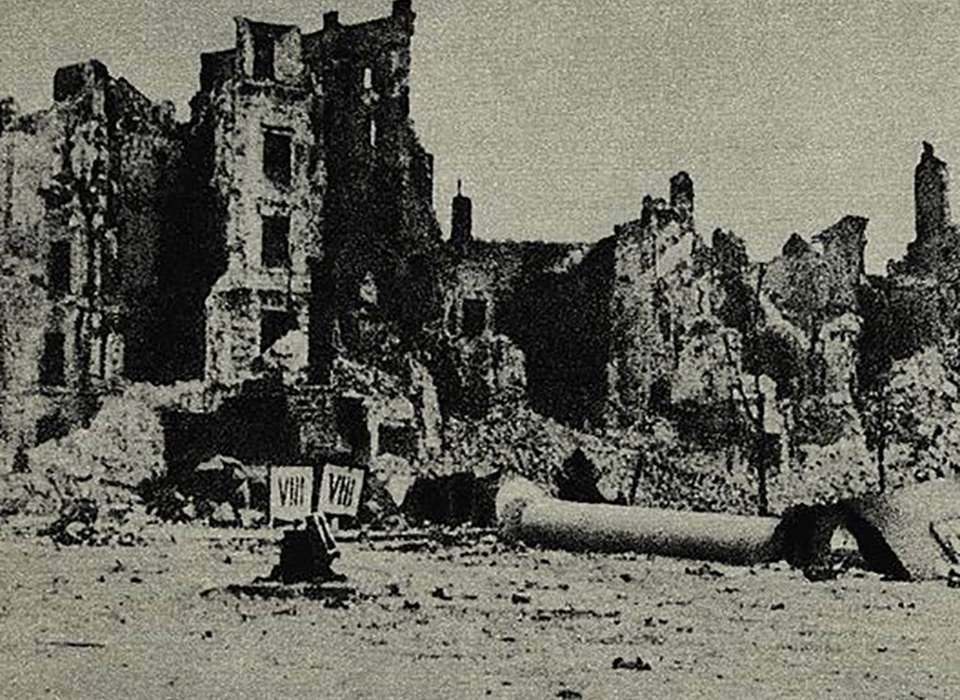




![Max Fuchs, New York City cantor, sings as Rabbi Sydney [sic] Lefkowitz, Richmond, VA, conducts the first Jewish services from Germany.](/sites/default/files/styles/max_650x650/public/2025-10/image1.jpg)



